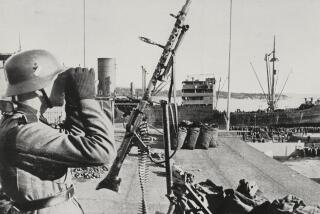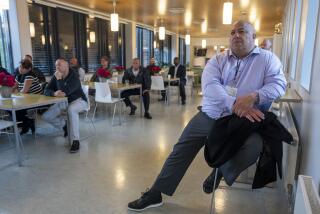Spirit of Old Oslo Is Alive on Its New Waterfront
- Share via
OSLO — Memory often gives us a view of the past through rose-colored glasses, so after an absence of more than 10 years I was apprehensive about returning to this Nordic capital, which I remembered so fondly.
I wanted to view Aker Brygge, the new waterfront revitalization project, but I also hoped to find enough of the earlier Oslo to confirm my recollections.
I needn’t have worried. It was all here, much as I had left it.
Oslo’s setting is still spectacular, wrapped around the magnificent, island-studded Oslo Fiord that carves deeply into the southern junction of Norway and Sweden.
Urban sprawl hasn’t noticeably diminished the number of lush parks, forests, hills and playgrounds so abundant in and around the city. In fact, all building has been on less than 12% of Oslo’s 175 square miles.
Easy to Explore
The heart of the city always has been easy to explore on foot, concentrated as it is around the waterfront.
Therefore, one of the first things I did on my trip down memory lane was to take a walk along the main street, Karl Johansgate, from the Royal Palace on a gentle hill at one end to a beautiful, 300-year-old cathedral at the other.
It was reassuring to pass the inviting shops and restaurants and see such other remembered landmarks as Norway’s Parliament House, the National Theater, the University of Oslo and the nearby National Art Museum.
As I wandered I noted that statues, theaters and museums in Oslo continued to pay tribute to three of their most famous sons--composer Edvard Grieg, playwright Henrik Ibsen and painter Edvard Munch.
I found a bolder tribute a short bus ride from town at Frogner Park, home to the works of noted artist and sculptor Gustav Vigelund.
In the 80-acre outdoor gallery are hundreds of massive unclothed figures, beautiful and bizarre, that the artist sculpted to depict the cycle of human life from birth to death.
In Oslo I stay at the Hotel Continental across from the National Theater and near the palace and waterfront. Although it, too, has undergone some cosmetic changes it remains one of Oslo’s most elegant hotels, with abundant Old World charm.
At one corner of the hotel is one of my favorite places, the lively Theatercafeen, a Viennese-type cafe that is popular with the lunch and pre- and post-theater crowds.
Others seek out the hotel’s Continental Bar, a more subdued room lined with a collection of the omnipresent works of Munch. Or enjoy the Annen Etage for gourmet dining.
Waterfront Stroll
Near the harbor, the Continental is around the corner and a few blocks down Roald Amundsgate from the waterfront.
Overlooking the harbor is the city hall, a twin-towered block of red stone filled with murals, sculptures and paintings by many of Norway’s contemporary artists.
Completed in 1950 in time for the celebration of Oslo’s 900th anniversary, its ostentatious design created almost as much controversy as Vigelund’s sculptures.
Facing the harbor with my back to city hall I could see the Akershus castle-fortress atop a promontory off to the left.
Built by Haakon V in 1300, about the time he decided to make Oslo the capital of Norway, it is one of the oldest buildings in Norway.
During World War II the Nazis used it as a headquarters. Vikdun Quisling, the infamous Norwegian traitor, was executed there.
On its grounds are the Resistance and Defense museums, both appealing to World War II buffs.
During an earlier visit, a group of fellow travelers and I had followed local custom--we bought some prawns at the dock, then wandered over to the castle and climbed the parapets to sit and eat as we took in the spectacular view of the harbor, the outlying islands and Bygdoy, a peninsular suburb of Oslo.
Bygdoy is the site of a collection of naval memorabilia: the Viking Ship Museum, with its three well-preserved Viking ships; the Fram Museum, with the polar ship Fram; the Kon Tiki Museum, with Thor Heyerdahl’s raft, and the Norwegian Maritime Museum, with Roald Amunsen’s Northwest Passage ship, the Gjoa.
Also on Bygdoy is the Norwegian Folk Museum, a collection of 150 preserved old buildings from all parts of Norway. It’s a worthwhile stop and easily reached by bus or ferry.
My interest on this trip, however, was on the big change occurring on the right side of the harbor, across the bay from Akershus.
Fisherman’s Wharf
I’d heard and read about Aker Brygge (Aker is a proper name and brygge means pier), the new “Fisherman’s Wharf” of Oslo that was patterned after San Francisco’s revitalized waterfront.
I wanted to see whether the huge entertainment, shopping and residential project was “retaining the waterfront atmosphere” and “reestablishing a closer link between city and sea,” as officials hoped, or whether it would wind up as another civic bone of contention.
From my vantage point in front of city hall the view was encouraging. I could still see the outline and facades of the old warehouses and the long, wood-planked wharf where ferryboats were loading and unloading passengers.
I followed the tide of pedestrians across the coast highway and headed to the wharf for a closer look.
Pleasure hunters seemed to have found a target. Street performers drew appreciative crowds; children shrieked and laughed as they slid down the slides in a play area; throngs sipped and snacked around small tables that filled the ferry landing platforms and sidewalk cafes, or munched finger foods from food stands. From somewhere the music of a Dixieland band filled the air.
Strolling the length of the promenade I saw that the shells of the old warehouses had, indeed, remained intact, though their interiors had been scooped out and another building added to create a spacious shopping mall. It is much like the larger ones in the United States, with specialty shops, restaurants and entertainment facilities.
Shops Galore
Already open or scheduled to open this summer are shops offering designer clothes, beauty care, toys, books, interior design, art and gifts, in addition to a post office, bank, supermarket, nightclub and theater.
To provide easier access, a new east-west highway and a new bus terminal are under construction to connect Aker Brygge with other parts of the city.
In addition, housing will be offered on upper floors and in buildings being built adjacent to the quayside shops. Walkways and plazas will connect them, and parking buildings will be built on the perimeter to keep the complex traffic-free.
Also planned are an expanded marina, an enclosed aquatic center and a “fun and adventure” center scheduled for completion by 1991.
As I sat at an outdoor table and watched the passengers pour off the ferryboats and stream in from town on foot, it was easy to see that Aker Brygge already had achieved its goal to renew the link between the city and sea. It also gave me a new memory of Oslo.
-- -- --
Rooms at the Continental begin at $120 double occupancy. A money saver is the Oslo Card, available at the tourist center and at many hotels. It offers discounts on many attractions and unlimited travel on public transportation.
For more information on travel to Norway, contact the Norwegian Tourist Board, 655 3rd Ave., 18th Floor, New York 10017, (212) 949-2333.
More to Read
Sign up for Essential California
The most important California stories and recommendations in your inbox every morning.
You may occasionally receive promotional content from the Los Angeles Times.













